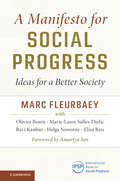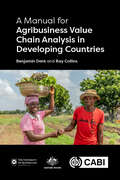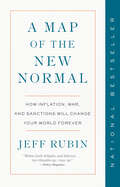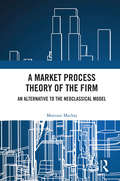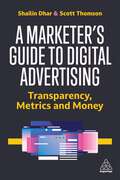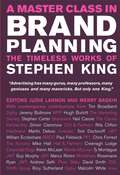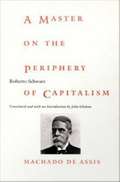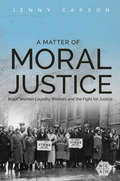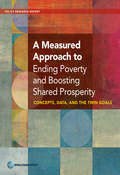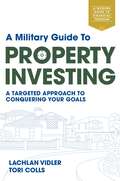- Table View
- List View
A Manifesto for Social Progress: Ideas For A Better Society
by Helga Nowotny Ravi Kanbur Marc Fleurbaey Elisa Reis Olivier Bouin Salles-Djelic Marie-LaureAt this time when many have lost hope amidst conflicts, terrorism, environmental destruction, economic inequality and the breakdown of democracy, this beautifully written book outlines how to rethink and reform our key institutions - markets, corporations, welfare policies, democratic processes and transnational governance - to create better societies based on core principles of human dignity, sustainability, and justice. This new vision is based on the findings of over 300 social scientists involved in the collaborative, interdisciplinary International Panel on Social Progress. Relying on state-of-the-art scholarship, these social scientists reviewed the desirability and possibility of all relevant forms of long-term social change, explored current challenges, and synthesized their knowledge on the principles, possibilities, and methods for improving the main institutions of modern societies. Their common finding is that a better society is indeed possible, its contours can be broadly described, and all we need is to gather forces toward realizing this vision.
A Manual for Agribusiness Value Chain Analysis in Developing Countries
by Dr Benjamin Dent Professor Ray CollinsValue Chain Analysis (VCA) diagnoses the current state of a value chain and makes recommendations to improve its effectiveness and efficiency. Applying VCA in developing countries is very often subject to limited time and funding. This manual shows how VCA principles can be applied under such circumstances. It explains how to undertake an affordable VCA that still generates valid data and so produces recommendations that will have impact. The manual has four parts: Part 1: Our Approach to Value Chain Thinking - sets out the principles and practice of taking a value chain approach. Part 2: Conducting Value Chain Analysis - covers planning a VCA, conducting consumer research, interviewing, analysing, creating recommendations and reporting. Part 3: Case Studies - illustrates successful VCAs with case studies e.g. Ghanaian pineapples and Kenyan indigenous chicken. Part 4: Further Reading and Biographies The practical style and content will make this manual accessible to a wide audience: NGO practitioners; government policymakers and extension officers; private sector managers and consultants; and academics for teaching and researching.
A Map of the New Normal: How Inflation, War, and Sanctions Will Change Your World Forever
by Jeff RubinNATIONAL BESTSELLERBestselling economist Jeff Rubin warns that the shock inflation of 2021 is the front of a perfect storm of war, supply-chain disruption, geopolitical realignment, domestic upheaval, and energy scarcity that will change everything.During the pandemic, government deficits skyrocketed to record highs while central banks primed the printing presses—and the time has come to pay for it. The ramifications of international COVID-19 spending could potentially last for decades, and inevitably one of the first consequences will be that central banks will lose control of interest rates, and subsequently, growth and inflation targets. The genie will be out of the bottle.That is just the first symptom of a series of cascading upheavals. Supply-chain disruptions have already shown the vulnerability of the globalist model that has fueled growth for the past decades. War has not only shown the fragility of the status quo, but has revealed diplomatic and economic rifts that promise to shift trading patterns. At the same time, the precarity of the US dollar underlines the life-or-death importance of foreign markets and resources, energy in particular. And consolidation of a Eurasian bloc, from Russia to China, and encompassing old enemies like Iran and former US ally Saudi Arabia, hint that the upheaval of COVID-19 was just the beginning.Tracking trade wars and kinetic wars, central banks and runs on banks, pipelines blown up and startups knocked down, A Map of the New Normal gives us a glimpse of a near future that will look very different from the recent past. It reminds us that our mortgage rates and job security, our grocery bills and investments, are all tied to events set in motion by governments, corporations, and black swans around the world.
A Map of the New Normal: How Inflation, War, and Sanctions Will Change Your World Forever
by Jeff RubinNATIONAL BESTSELLERBestselling economist Jeff Rubin warns that the shock inflation of 2021 is the front of a perfect storm of war, supply-chain disruption, geopolitical realignment, domestic upheaval, and energy scarcity that will change everything.During the pandemic, government deficits skyrocketed to record highs while central banks primed the printing presses—and the time has come to pay for it. The ramifications of international COVID-19 spending could potentially last for decades, and inevitably one of the first consequences will be that central banks will lose control of interest rates, and subsequently, growth and inflation targets. The genie will be out of the bottle.That is just the first symptom of a series of cascading upheavals. Supply-chain disruptions have already shown the vulnerability of the globalist model that has fueled growth for the past decades. War has not only shown the fragility of the status quo, but has revealed diplomatic and economic rifts that promise to shift trading patterns. At the same time, the precarity of the US dollar underlines the life-or-death importance of foreign markets and resources, energy in particular. And consolidation of a Eurasian bloc, from Russia to China, and encompassing old enemies like Iran and former US ally Saudi Arabia, hint that the upheaval of COVID-19 was just the beginning.Tracking trade wars and kinetic wars, central banks and runs on banks, pipelines blown up and startups knocked down, A Map of the New Normal gives us a glimpse of a near future that will look very different from the recent past. It reminds us that our mortgage rates and job security, our grocery bills and investments, are all tied to events set in motion by governments, corporations, and black swans around the world.
A Market Process Theory of the Firm: An Alternative to the Neoclassical Model (Routledge Studies in the Economics of Business and Industry)
by Mateusz MachajNeoclassical economics has been criticized from various angles by orthodox schools. The same can be said about its particular branch: the theory of the firm. This book demonstrates how a successful theory of the firm can be presented without flawed notions of a neoclassical framework and used to comprehend actual business history. The author argues that we should start from the assumption that businesses are inevitably imponderable, as that is their nature, in the process of economic evolution. The book offers an in-depth exploration of neoclassical limitations by examining each of the small details associated with the famous MR = MC rule. It follows a step-by-step approach, which starts off with neoclassical assumptions and then moves into more empirically sound theory, based on modeling logic and rooted in real world examples. The author presents a novel discussion on the size of the firm, both in terms of classifying a firm’s expansion and about the factors that limit the size of the firm and argues how formal pricing theory can be built using more indeterminate assumptions about firms. Further, there is a discussion on how firms are rooted in amorphous industries, which helps to explain economic progress better by emphasizing the importance of economic experiments, mistakes and bankruptcies. This is a valuable reference for scholars and researchers who are interested in a range of topics from microeconomics, through pricing theory to industrial organization, history of economic thought and managerial economics.
A Marketer's Guide to Digital Advertising: Transparency, Metrics, and Money
by Shailin Dhar Scott ThomsonHow can individual marketers and their teams navigate the complex issues that seem to overwhelm the digital advertising industry today? They can learn about the metrics worth using, the importance of measurement and the technology available. With contradictory rules surrounding data privacy, measurement constraints, changes to supply chains and other complexities often too difficult to approach, the world of marketing is more complex than ever before. A Marketer's Guide to Digital Advertising helps marketers navigate the complicated world of digital advertising by diving into the metrics, money and technology fueling the marketing industry. Digital advertising consultants Shailin Dhar and Scott Thomson outline the forces shaping the current digital landscape and the common responses from advertisers trying to design their digital strategy. Walking readers through the common missteps made within digital advertising, they provide useful insight into measurement and thoughtful alternatives to practices often found lower on a company's priorities list. A Marketer's Guide to Digital Advertising offers ways to minimize waste and improve outcomes for brands and their business partners. The book illuminates the gap between in-house marketing teams, agency professionals and tech partners whilst helping readers make sense of the way money flows through the global ad industry.
A Marxist History of Capitalism
by Henry HellerHenry Heller’s short account of the history of capitalism combines Marx’s economic and political thought with contemporary scholarship to shed light on the current capitalist crisis. It argues that capitalism is an evolving mode of production that has now outgrown its institutional and political limits. The book provides an overview of the different historical stages of capitalism, underpinned by accessible discussions of its theoretical foundations. Heller shows that capitalism has always been a double-edged sword, on one hand advancing humanity, and on the other harming traditional societies and our natural environment. He makes the case that capitalism has now become self-destructive, and that our current era of neoliberalism may trigger a transition to a democratic and ecologically aware form of socialism.
A Master Class in Brand Planning
by Judie Lannon Merry BaskinIn 1988, on Stephen King's retirement JWT published 'The King Papers' a small collection of Stephen King's published writings spanning 1967-1985. They remain timelessly potentially valuable but are an almost unexploited gold mine. This book is comprised of a selection of 20-25 of Stephen King's most important articles, each one introduced by a known and respected practitioner who, in turn, describes the relevance of the particular original idea to the communications environment of today.The worth of this material is that, although the context in which the original papers were written is different, the principles themselves are appropriate to marketing communications in today's more complex media environment. The book will serve as a valuable reference book for today's practitioners, as well as a unique source of sophisticated, contemporary thinking.
A Master on the Periphery of Capitalism: Machado De Assis
by Roberto SchwarzA Master on the Periphery of Capitalism is a translation (from the original Portuguese) of Roberto Schwarz's renowned study of the work of Brazilian novelist Machado de Assis (1839-1908). A leading Brazilian theorist and author of the highly influential notion of "misplaced ideas," Schwarz focuses his literary and cultural analysis on Machado's The Posthumous Memoirs of Brás Cubas, which was published in 1880. Writing in the Marxist tradition, Schwarz investigates in particular how social structure gets internalized as literary form, arguing that Machado's style replicates and reveals the deeply embedded class divisions of nineteenth-century Brazil. Widely acknowledged as the most important novelist to have written in Latin America before 1940, Machado had a surprisingly modern style. Schwarz notes that the unprecedented wit, sarcasm, structural inventiveness, and mercurial changes of tone and subject matter found in The Posthumous Memoirs of Brás Cubas marked a crucial moment in the history of Latin American literature. He argues that Machado's vanguard narrative reflects the Brazilian owner class and its peculiar status in both national and international contexts, and shows why this novel's success was no accident. The author was able to confront some of the most prestigious ideologies of the nineteenth century with some uncomfortable truths, not the least of which was that slavery remained the basis of the Brazilian economy. A Master on the Periphery of Capitalism will appeal to those with interests in Latin American literature, nineteenth century history, and Marxist literary theory.
A Masterpiece of Revenge: A Mystery
by J. J. FiechterFrom the author of comes a wickedly ingenious psychological thriller involving a priceless painting and a murderous plot to use it for revenge. Gripping from first page to last, A MASTERPIECE OF REVENGE is a classic Hitchcockian thriller that will keep the reader guessing every step of the way.
A Mathematical Approach to Marxian Value Theory: Time, Money, and Labor Productivity (Marx, Engels, and Marxisms)
by Dong-Min RieuThis book clarifies the quantitative relationship between time, money, and labor productivity from the perspective of Marxian labor theory of value. The book is divided into four main parts. Part I introduces the relationship between time and money in the context of Marxian value theory. Part II explores the theory of labor exploitation. Part III turns to analysis of the rate of profit, which is a primary characteristic of classical and Marxian economics. Part IV is devoted to suggesting a new research direction in light of the main conceptual innovation of the book.
A Mathematical Look at Politics
by E. Arthur Robinson Jr. Daniel H. UllmanWhat Ralph Nader's spoiler role in the 2000 presidential election tells us about the American political system. Why Montana went to court to switch the 1990 apportionment to Dean's method. How the US tried to use game theory to win the Cold War, and why it didn't work. When students realize that mathematical thinking can address these sorts of pres
A Mathematician Plays The Stock Market
by John Allen PaulosIn A Mathematician Plays the Stock Market best-selling author John Allen Paulos demonstrates what the tools of mathematics can tell us about the vagaries of the stock market. Employing his trademark stories, vignettes, paradoxes, and puzzles (and even a film treatment), Paulos addresses every thinking reader's curiosity about the market: Is it efficient? Is it rational? Is there anything to technical analysis, fundamental analysis, and other supposedly time-tested methods of picking stocks? How can one quantify risk? What are the most common scams? What light do fractals, network theory, and common psychological foibles shed on investor behavior? Are there any approaches to investing that truly outperform the major indexes? Can a deeper knowledge of mathematics help beat the odds?All of these questions are explored with the engaging erudition that made Paulos's A Mathematician Reads the Newspaper and Innumeracy favorites with both armchair mathematicians and readers who want to think like them. Paulos also shares the cautionary tale of his own long and disastrous love affair with WorldCom. In the tradition of Burton Malkiel's A Random Walk Down Wall Street and Jeremy Siegel's Stocks for the Long Run, this wry and illuminating book is for anyone, investor or not, who follows the markets-or knows someone who does.
A Matter of Moral Justice: Black Women Laundry Workers and the Fight for Justice (Working Class in American History #1)
by Jenny CarsonA long-overlooked group of workers and their battle for rights and dignity Like thousands of African American women, Charlotte Adelmond and Dollie Robinson worked in New York’s power laundry industry in the 1930s. Jenny Carson tells the story of how substandard working conditions, racial and gender discrimination, and poor pay drove them to help unionize the city’s laundry workers. Laundry work opened a door for African American women to enter industry, and their numbers allowed women like Adelmond and Robinson to join the vanguard of a successful unionization effort. But an affiliation with the powerful Congress of Industrial Organizations (CIO) transformed the union from a radical, community-based institution into a bureaucratic organization led by men. It also launched a difficult battle to secure economic and social justice for the mostly women and people of color in the plants. As Carson shows, this local struggle highlighted how race and gender shaped worker conditions, labor organizing, and union politics across the country in the twentieth century. Meticulous and engaging, A Matter of Moral Justice examines the role of African American and radical women activists and their collisions with labor organizing and union politics.
A Matter of Taste: A Farmers' Market Devotee's Semi-Reluctant Argument for Inviting Scientific Innovation to the Dinner Table (Exploded Views)
by Rebecca TuckerHow did farmer's markets, nose-to-tail, locavorism, organic eating, CSAs, whole foods, and Whole Foods become synonymous with “good food”? And are these practices really producing food that is morally, environmentally, or economically sustainable? Rebecca Tucker's compelling, reported argument shows that we must work to undo the moral coding that we use to interpret how we come by what we put on our plates. She investigates not only the danger of the accepted rhetoric, but the innovative work happening on farms and university campuses to create a future where nutritious food is climate-change resilient, hardy enough to grow season after season, and, most importantly, available to all—not just those willing or able to fork over the small fortune required for a perfect heirloom tomato. Tucker argues that arriving at that future will require a broad cognitive shift away from the idea that farmer's markets, community gardens, and organic food production is the only sustainable way forward; more than that, it will require the commitment of research firms, governments, corporations, and postsecondary institutions to develop and implement agriscience innovations that do more than improve the bottom line. A Matter of Taste asks us to rethink what good food really is.
A Measured Approach to Ending Poverty and Boosting Shared Prosperity
by World BankIn 2013, the World Bank Group adopted two new goals to guide its work: ending extreme poverty and boosting shared prosperity. More specifically, the goals are to reduce extreme poverty in the world to less than 3 percent by 2030, and to foster income growth of the bottom 40 percent of the population in each country. While poverty reduction has been a mainstay of the World Bank's mission for decades, the Bank has now set a specific goal and timetable, and for the first time, the Bank has explicitly included a goal linked to ensuring that growth is shared by all. The discussion until now has centered primarily on articulating the new goals. This report, the latest in World Bank's Policy Research Report series, goes beyond that and lays out their conceptual underpinnings, discusses their relative strengths and weaknesses by contrasting them with alternative indicators, and proposes empirical approaches and requirements to track progress towards the goals. The report makes clear that the challenges posed by the World Bank Group's new stance extend not just to the pursuit of these goals but, indeed, to their very definition and empirical content. The report also argues that an improved data infrastructure, consisting of many elements including the collection of more and better survey data, is critical to ensure that progress towards these goals can be measured, and policies to help achieve them can be identified and prioritized.
A Medicated Empire: The Pharmaceutical Industry and Modern Japan (Studies of the Weatherhead East Asian Institute, Columbia University)
by Timothy M. YangIn A Medicated Empire, Timothy M. Yang explores the history of Japan's pharmaceutical industry in the early twentieth century through a close account of Hoshi Pharmaceuticals, one of East Asia's most influential drug companies from the late 1910s through the early 1950s. Focusing on Hoshi's connections to Japan's emerging nation-state and empire, and on the ways in which it embraced an ideology of modern medicine as a humanitarian endeavor for greater social good, Yang shows how the industry promoted a hygienic, middle-class culture that was part of Japan's national development and imperial expansion. Yang makes clear that the company's fortunes had less to do with scientific breakthroughs and medical innovations than with Japan's web of social, political, and economic relations. He lays bare Hoshi's business strategies and its connections with politicians and bureaucrats, and he describes how public health authorities dismissed many of its products as placebos at best and poisons at worst. Hoshi, like other pharmaceutical companies of the time, depended on resources and markets opened up, often violently, through colonization. Combining global histories of business, medicine, and imperialism, A Medicated Empire shows how the development of the pharmaceutical industry simultaneously supported and subverted regimes of public health at home and abroad.
A Mentalidade do Escritor
by Falcon Storm Gabriel Martimiano PiresA Mentalidade Do Escritor por Falcon Storm Tornar-se um escritor é simples como ajustar a sua mentalidade e mudar as habilidades que você já tem, saiba o que você precisa para alcançar o seu sonho hoje. Você sente que o seu propósito de vida é ser um escritor e compartilhar histórias da sua cabeça com o resto do mundo? Você almeja escrever o novo romance de grande sucesso? Talvez já tenha escrito alguns livros, mas quer levar os esforços de produtividade, talento e marketing a outros patamares, talvez já tenha começado como um escritor e se sentiu perdido nas várias tarefas que esperam por você, talvez esteja parado no primeiro quadrado, sem ter ideia do que fazer, aonde ir, até mesmo se deve escrever. A Mentalidade do Escritor está aqui para lhe ajudar! Em poucas horas, você vai aprender o básico para ser um escritor profissional, você vai aprender mais do que colocar palavras no papel, você vai aprender como entrar na mentalidade de um escritor e ficar lá, cavando o seu nicho no mundo literário, com esse guia, você vai aprender também: Descubra a diferença entre escritores e todos os outros Colocar metas específicas e atingíveis para a sua carreira Trabalhar com o tempo de forma eficaz Melhorar a habilidade de escrita Criar um produto profissional Alavancar a sua marca de escritor Construir um site de escritor Identificar o que fazer e o que não fazer nas redes sociais Tornar-se parte de uma comunidade online de escritores ou leitores Comece como um escritor profissional HOJE Oferecemos 5 brindes exclusivos para os leitores desse livro! A Nossa Garantia: Está cansado de livros para fazer marketing de livros que focam mais na história de vida do escritor do que em conselhos que você pode usar na sua carreira? Ou, pior ainda, guias de conselhos que são direcionados para escritos de não-ficção e têm poucas informações úteis para romancistas?
A Message to Garcia: And Treasured Wisdom
by Mitch Horowitz Elbert HubbardHistory's Greatest Motivational Lesson: Now in a Definitive Edition with Gems of Wisdom from Elbert HubbardThis remarkably concise, powerful statement on what makes a person successful remains as relevant today as when it was written more than a century ago. If you take seriously the principle of Elbert Hubbard's A Message to Garcia, you will become the indispensible, productive, successful, and respected person you have always wished to be. All that is required is for you to "carry a message to Garcia" - which means to do a job simply as it should be done. Discover for yourself the incredible power hidden in this one step. This edition of A Message to Garcia surpasses other volumes because it includes short passages of life-advice from Hubbard, which elucidate his message and demonstrate how to put it into action.Selected and introduced by PEN Award-winning historian Mitch Horowitz, this slender volume offers a life-changing journey into a single idea that can make all the difference in your earning power, effectiveness, and success. The Condensed Classics Library"40 Minutes to a New You"
A Method for Calculating Export Supply and Import Demand Elasticities
by Stephen TokarickA report from the International Monetary Fund.
A Mighty Fine Road: A History of the Chicago, Rock Island & Pacific Railroad Company
by H. Roger Grant“Grant has once again hit a home run . . . a detailed but readable history of the Chicago, Rock Island and Pacific, a major Midwestern railroad.” —Carlos A. Schwantes, St. Louis Mercantile Library Professor EmeritusThe Chicago, Rock Island & Pacific Railroad’s history is one of big booms and bigger busts. When it became the first railroad to reach and then cross the Mississippi River in 1856, it emerged as a leading American railroad company. But after aggressive expansion and a subsequent change in management, the company struggled and eventually declared bankruptcy in 1915. What followed was a cycle of resurrections and bankruptcies; a grueling, ten-year, ultimately unsuccessful battle to merge with the Union Pacific; and the Rock Island’s final liquidation in 1981. But today, long after its glory days and eventual demise, the “Mighty Fine Road” has left behind a living legacy of major and feeder lines throughout the country. In his latest work, railroad historian H. Roger Grant offers an accessible, gorgeously illustrated, and comprehensive history of this iconic American railroad.“This handsome, well-illustrated book merits the attention of any reader interested in the history of Iowa. And just as important, the book reminds us of the importance of railroads to the history and vitality of American society. All aboard!” —Iowa City Press-Citizen“A Mighty Fine Road lays out the amazing, yet heartbreaking history of the railroad I loved. The historical opportunities and disappointments of the Rock Island is clearly explained in Grant’s book, with visionaries keeping the dream moving forward, yet damaged and constrained by greed and lack of vision with the next management regime.” —Dan Sabin, President, Iowa Northern Railway Company
A Migrant Family
by Larry Dane BrimnerWe all know what a supermarket is, but what is a farmer's market? It's a place where people gather together to sell products -- such as flowers, herbs, vegetables, fruit, and more -- that they have grown or produced. Through lively text, readers will meet two families -- one Hmong American and the other German American -- as they work hard to prepare for a busy market season.
A Mile of Make-Believe: A History of the Eaton's Santa Claus Parade
by Steve PenfoldA Mile of Make Believe examines the unique history of the Santa Claus parade in Canada. This volume focuses on the Eaton's sponsored parades that occurred in Toronto, Montreal and Winnipeg as well as the shorter-lived parades in Calgary and Edmonton. There is also a discussion of small town alternatives, organized by civic groups, service clubs, and chambers of commerce. By focusing on the pioneering effort of the Eaton's department store Steve Penfold argues that the parade ultimately represented a paradoxical form of cultural power: it allowed Eaton's to press its image onto public life while also reflecting the decline of the once powerful retailer. Penfold's analysis reveals the "corporate fantastic" - a visual and narrative mix of meticulous organization and whimsical style- and its influence on parade traditions. Steve Penfold's considerable analytical skills have produced a work that is simultaneously a cultural history, history of business and commentary on consumerism. Professional historians and the general public alike would be remiss if this wasn't on their holiday wish list.
A Military Guide to Property Investing: A targeted approach to conquering your goals
by Lachlan Vidler Tori CollsA 10-step guide to achieving financial freedom through property investing. Property investing has long been recognised as one of the most successful long-term wealth creation strategies. With interest rates at all-time lows, it looks set to continue to be so. There are so many approaches to property investing, it's no wonder people struggle to understand the fundamentals that drive success in property. This comprehensive, easy-to-understand guide aims to educate readers on how they can begin their own property investment journey with ruthless military precision and efficiency. Written by two former military professionals, Lachlan Vidler and Tori Colls, A Military Guide to Property Investing presents the step-by-step method they followed to amass an impressive portfolio of properties while still in their twenties. Based on the military principles of strategy, discipline and execution, it offers a fail-safe plan to take control of your financial destiny.
